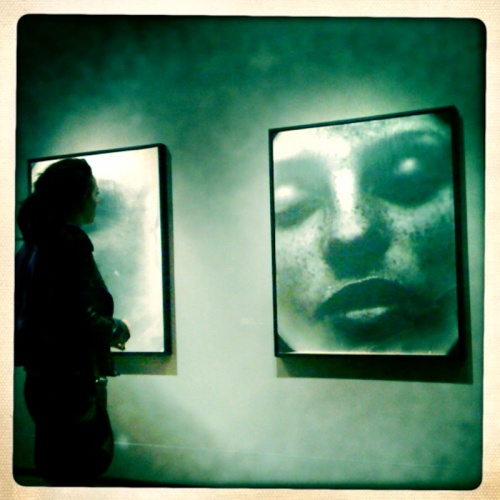The Photographer’s Gallery might be the strangest gallery space I have been in. It worked perfectly with the Sally Mann exhibition they put on – titled The Family and The Land – using the very structure of the building to physically structure her show.
To view the next part of the exhibition, I had to take the stairs to the third floor and was met by a more classic style of portraits, in the series that Mann calls “Immediate Family,” which depicts intimate portraits of her children in their homestead in Virginia. The images are crisp and show Mann’s children in an Eden-like wilderness. Her children are nude, skinny dipping, laying in the sun, and playing in the high grass. The series shows the romantic side of childhood while still using the same images to portray a stunning experiential landscape and the vastness of it in comparison to the fragility of children. The photograph of Vanessa, Mann’s eldest daughter, smoking a play-cigarette, is such a powerful image, because it embodies a paradox, which is hard to deal with visually because of the hardness and adulthood implied in the icon of the cigarette and the lightheartedness and innocence of the young blonde girl in the lacy white dress.
The third room was solely a series of landscapes, showing – now, in a protagonistic role – the natural landscape of Virginia and other locations in the southern United States. The sites are predominantly battle sites of the Civil War, and the shots are wide and busy. It seems that Mann drew her focus away from the expression, fragility, scars and details of her children, and concentrated on the scars and details that the land suffered as a consequence of human violence.
The first room showed Sally Mann’s largest portraits; more importantly portraits, close-ups, of her children’s faces. The process she uses for these is particularly important because of their size (huge!). To make her images, Sally Mann uses the wet-plate collodion process, which makes the negative by coating a glass plate with collodion to make a wet emulsion: the plate is sensitized in a silver NO3 solution and is exposed to light while still wet.
The process only allows about five minutes to make the exposure after the plate is sensitized, but the exposures seem long, because of the blur, shakiness and soft nature of the portraits. It’s almost as if the faces of her children are representing the, never still, scribbled movement of childhood and human life. Since the photographs are major close-ups at a massive scale, throwing the power of features and expression, along with the serendipitous nature of the developing process itself into a message of both the naïveté of childhood, as well as the insecurities associated with youth.
(more after the jump)
 |
| We weren't allowed pictures, but I snagged one with the Hipstamatic app on my phone. |
(more after the jump)
 |
| Jessie at 6 |
 |
| Candy Cigarette |
 |
| Scarred Tree |
The fourth and final room explores a combination of both the images of humanity and the human impact within and on nature expressed in the three previous rooms by using photographs of corpses in various processes of decay into the earth and – by doing so – completes the cycle of natural life that Mann maps out within the creative evolution of her work.
One of the most striking images, for me, was a close shot of a decomposing face – gathering enough detail to grasp the shape of it, but leaving enough out of the range of focus to that the concept of fading into nature is still prominent from a purely visual sense. From birth, childhood, the evolution of surrounding life, and ultimately death, decomposition and a return to nature, The Family and The Land is a collective body of work that addresses both the integration of nature in the lives of humans, as well as the integration of humans in the life of nature.
 |
| Untitled |
Uh...Isa. Are you aware how amazing these pictures are? Like...woah. I'm glad my friends are so ridiculously talented and creative, it makes me feel slightly less 'square'.
ReplyDelete